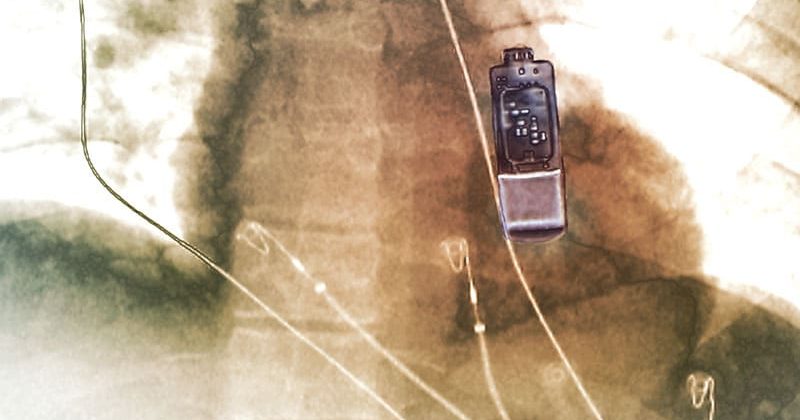Bradycardia is a lot more common than generally believed, but is often asymptomatic and not clinically relevant, and may lead to needless pacemaker therapy, suggests a post-hoc analysis of a major study.
The arrhythmia’s presence overall in the randomized LOOP trial predicted an excess risk of syncope and death, and it didn’t matter how it was detected. Bradyarrhythmia revealed incidentally at long-term cardiac rhythm monitoring was no more predictive than when it was picked up in a usual-care setting.
Still, people in the trial with implantable loop recorders (ILR) had six times the chance of being diagnosed with bradyarrhythmias than those in the usual-care control group. LOOP entered older persons in the community without known arrhythmias but with risk factors like diabetes or hypertension.
About 80% of such arrhythmias at ILR monitoring were asymptomatic, compared to less than one fourth in the usual-care group. Yet pacemaker implantation for bradyarrhythmia was 53% more likely in the ILR group, according to a report published February 15 in JAMA Cardiology.
Most participants with asymptomatic bradycardia did not receive treatment for it, yet the study — despite the mostly conservative management — still showed “overtreatment with pacemakers” in the ILR group, observed lead author Søren Zöga Diederichsen, MD, PhD, Copenhagen University Hospital–Rigshospitalet, Copenhagen, Denmark.
Bradyarrhythmia overall predicted later syncope and all-cause and cardiovascular (CV) death, but did so regardless of whether the patient was ILR-monitored or received a pacemaker, Diederichsen told theheart.org | Medscape Cardiology.
“We didn’t see any signal, not even a small signal, toward a health benefit from monitoring and detecting bradycardias, or from acting on them conservatively or implanting pacemakers,” he noted.
The study “emphasizes that you should have symptoms” to justify pacemaker therapy for bradyarrhythmias, regardless of how they were detected, Diederichsen said.
“Clearly ILRs may identify patients with bradyarrhythmias deserving of treatment” when they are associated with symptoms, an accompanying editorial agrees. In the current analysis, however, “a large proportion of bradycardic events were completely asymptomatic.” Yet bradycardia predicted syncope and CV death in both the ILR and usual care groups, it notes.
“This does raise the question as to whether bradyarrhythmia may be a risk marker for underlying nonarrhythmic conditions to which preventive strategies and treatment should be directed,” write editorialists Mark H. Schoenfeld, MD, Yale University, New Haven, Connecticut, and Kristen K. Patton, MD, University of Washington, Seattle.
“In an aging population with ever-increasing comorbidities, it may become increasingly important to rule out bradycardia as a manifestation of a more sinister underlying disease,” they note, and to identify “patients who may be particularly vulnerable to adverse outcomes of progressive distal conduction disease.”
The previously published LOOP trial, conducted at four sites in Denmark, compared ILR screening for AF to usual care in 6004 patients at least 70 years or older, most with hypertension. The main results showed little benefit from screening for AF in prevention of incident stroke or systemic embolism over about 5 years.
The current LOOP analysis, post-hoc with all the associated limitations, followed incident bradyarrhythmia in the ILR and usual-care groups; any treatment of the arrhythmia was at physician discretion. The total cohort averaged 75 years in age and 47.3% were women.
The rate of incident bradyarrhythmia was 8.1% overall; it was 20.8% for those with ILR monitoring and 3.8% in the usual care group, for a hazard ratio (HR) of 6.21 (95% CI, 5.15 – 7.48, P < .001).
The arrhythmia was asymptomatic in 23.8% of usual-care patients and 79.8% of those with an ILR.
Bradyarrhythmia was significantly more likely among older patients, male patients, and those with a history of syncope, the group reported.
Pacemakers were implanted for bradyarrhythmia in 2.9% of usual-care patients and 4.5% of those with ILR monitoring for an HR of 1.53 (95% CI, 1.14 – 2.06, P < .001).
Among usual-care patients, bradyarrhythmia (vs no bradyarrhythmia) was associated with 5.2 times the risk for incident syncope (P < .001). That risk for syncope went up 2.6 times (P = .01) in the ILR group.
The corresponding risks for CV death among controls and among ILR patients increased 4.8 times (P < .001) and by 3.1 (P < .001), respectively. The risks for death from any cause tripled (P < .001) and rose 2.5 times (P < .001) among bradycardic controls and ILR patients, respectively.
Bradyarrhythmia was not significantly related to sudden cardiac death in either group, the report notes.
Given the increasing use of heart rhythm monitoring “inside and outside the clinical setting,” it states, “bradyarrhythmias are likely to be detected more often, sometimes as an incidental finding. Knowledge about the underlying prevalence and prognostic significance could help guide decisions.”
The study “teaches us a little bit” about the true prevalence of bradyarrhythmias in the general population, including asymptomatic cases that appear to be subclinical or “physiological,” Diederichsen said in an interview.
It also suggests that such bradycardia will be increasingly observed as use of ILR for arrhythmia screening expands in practice, he predicted. It may also be picked up more often by wearables and other rhythm-monitoring technology used by the public.
In the latter case especially, Diederichsen said, the current analysis could potentially help alleviate any concerns that bradyarrhythmia without symptoms is something that has to be specifically treated.
Diederichsen discloses grants from the Innovation Fund Denmark, the Research Foundation for the Capital Region of Denmark, the Danish Heart Foundation, Aalborg University Talent Management Programme, Arvid Nilssons Fond, Skibsreder Per Henriksen, R. og Hustrus Fond, European Union Horizon 2020, and Medtronic; and personal fees from Vital Beats and Bristol-Myers Squibb/Pfizer. Disclosures for the other authors are in the report. Schoenfeld reports ownership of stock from Apple. Patton reports employment as a medical officer for the US Food and Drug Administration and serving as associate editor for JAMA Cardiology.
JAMA Cardiol. Published online February 15, 2023. Full text, Editorial
Follow Steve Stiles on Twitter: @SteveStiles2. For more from theheart.org | Medscape Cardiology, follow us on Twitter and Facebook
Source: Read Full Article
